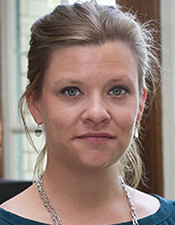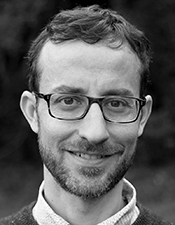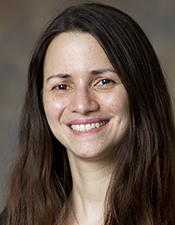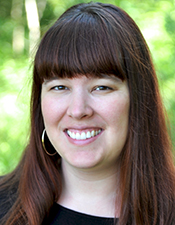2017-2018 Wimmer Faculty Fellows
We are pleased to announce the 2017-2018 Wimmer Faculty Fellows. These fellowships are made possible by a grant from the Wimmer Family Foundation and are designed for junior faculty members interested in enhancing their teaching through concentrated work designing or re-designing a course, innovating new materials, or exploring a new pedagogical approach. Fellows work in close collaboration with Eberly Center colleagues and receive a stipend to acknowledge the work it takes to improve one's effectiveness as an educator.
 |
Joshua BardAssistant Professor |
The students in Joshua’s Low-Relief: The Virtual and Material Cultures of Architectural Deceit class partnered with the Carnegie Museum of Art to bring their studio work to a public audience. Students displayed their work in a museum gallery space, and were challenged to communicate their design processes and products with gallery patrons. Josh worked with the Eberly Center to develop an “exhibition design component” for each course project. This component served as “a pedagogical tool encouraging students to think about issues of communication with an interested but architecturally untrained public.” In addition to the exhibition design component, students also created a welcome center with various interactive elements, including ones that allowed for communication between students and gallery patrons when either party was not physically present in the space. Reflecting upon their experience in the course, students said that having a public audience not only led them to produce a higher quality work, but also that they were “much more intentional about how they approached verbal, written, and visual forms of communication.”
 |
Sarah ChristianAssistant Teaching Professor |
Sarah redesigned her Materials Lab course to challenge her students to “think like engineers.” She accomplished this by implementing inquiry-based learning techniques that required students to predict and test out hypotheses, rather than simply following a “recipe” or set of instructions to prove or disprove their prediction. For example, rather than follow prescribed experimental steps to discover the properties of masonry, students were asked to “build a garage.” This project required students to generate and use the underlying engineering principles and concepts in a realistic setting, rather than following prescribed instructions in a contrived, laboratory setting. Students scored 10% higher on test questions related to content covered in inquiry-based labs compared to recipe-based labs. Additionally, Sarah attests that, as a result of this change, students “have a much better understanding [of] how and why we use data, probability, and statistics to develop design properties.”
To see Sarah present on her Wimmer project at CMU’s Annual Teaching & Learning Summit, click here.
 |
Stefan GruberAssistant Professor |
Prior to his Wimmer project, much of Stefan’s teaching experience has been in project-based studios of 10-15 students, where he developed and refined many effective teaching strategies. His Wimmer project sought to translate these strategies to his Architecture and Cities course, which enrolls 70 students. He was able to accomplish this goal in several ways. First, he implemented active learning exercises (e.g., fish-bowl discussions and Pecha Kucha presentations) during his “lecture” sessions, so that students were sufficiently engaged with course content. Second, in order to allow for personalized, frequent feedback on student work, he implemented “speed-dating-style feedback” with student peers. This approach allowed students to share and (immediately) receive feedback on components of their projects (e.g., defining a research question) without needing to wait for Stefan and his TA’s to grade all 70 assignments. In a way, this mimics the studio approach where an instructor might circulate among students and provide feedback on a student’s work, skill set, and knowledge. According to Stefan, this process of isolating skills and knowledge, “prompted [students] to reflect on and synthesize the acquired techniques, thus also providing an important piece of feedback for me, about what [had] registered and what [hadn’t].”
 |
Maryam SaeediAssistant Professor |
Maryam designed a new course entitled Designing the Digital Economy, which aimed to connect economic theory and practice through the use of case studies. This approach requires a significant amount of participation from students during class. Maryam worked with the Eberly Center to design in-class activities and implement teaching strategies that would maximize student engagement. Additionally, Maryam received guidance on structuring group work and developing rubrics to assess course assignments. While she initially developed these teaching interventions for her Designing the Digital Economy Course, Maryam says that they could easily be adapted and applied to any of her classes. The students really seemed to enjoy the case studies, and she will continue to revise them in order to make the connections between theory and practice more apparent for students.
 |
Alexa WoloshynAssistant Professor |
Alexa challenged her Music History III students to become inclusive musicologists by getting them to interrogate the existing musical canon, and to broaden their knowledge of the musical landscape by exploring underrepresented composers, especially women and artists of color. The pedagogical approach she implemented was to “juxtapose the typical ‘great white man’ with diverse composers and their works, without drawing attention to their inclusion; instead, all examples were presented as equal in their musical value while also recognizing historical context.” To assess student progress towards these goals, Alexa developed new assignments that allowed students to explore their own musicological interests while also synthesizing course content. By the end of the course, students had not only explored more composers than in previous versions of the course, but these composers represented more diverse backgrounds and perspectives.
To see Alexa present on her Wimmer project at CMU’s Annual Teaching & Learning Summit, click here.